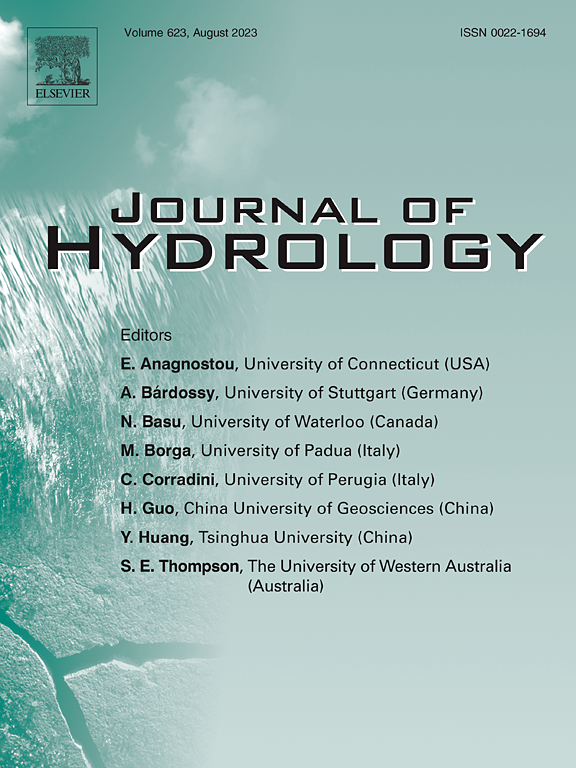太平洋海温对全球陆地干湿状况的可预测性:非线性动力系统的新视角
IF 5.9
1区 地球科学
Q1 ENGINEERING, CIVIL
引用次数: 0
摘要
海洋状态显著影响干湿条件(DWC)的时间变率。量化它们对DWC可预测性的贡献对于干旱和极端雨发事件的预警和预防至关重要。由于复杂的物理机制,海洋状态与DWC之间的关系本质上是非线性的,需要一种能够解决这种非线性的统计工具,以便更好地量化。本研究利用非线性动力系统(NDS)理论来理解DWC的可预测性,并利用收敛交叉映射(CCM)来评估海温(SST) indices-Niño1 + 2和Niño3.4-to对全球降水和DWC可预测性的贡献。以珠江流域为例,阐述了CCM的计算方法及其结果的解释。例如,通过CCM技能表明,Niño1 + 2约占PRB降水可预测性的0.78,而Niño3.4约占0.46。在此基础上,利用CCM方法绘制了海温对全球地表降水和DWC贡献的空间分布图,突出了海温贡献最大和最小的区域。更重要的是,我们证实了CCM和NDS理论对海温和DWC的适用性,验证了我们的发现,并表明NDS的可预测性是短期的,但具有确定性。作为第一次尝试,本研究提供了更多的途径来理解DWC的可预测性,并基于NDS理论从全球角度量化海洋国家对DWC的贡献。本文章由计算机程序翻译,如有差异,请以英文原文为准。
The predictability of global land dry-wet condition contributed by sea surface temperature of Pacific: A new perspective from nonlinear dynamical system
Ocean states significantly influence the temporal variability of dry-wet conditions (DWC). Quantifying their contribution to DWC predictability is crucial for drought and extreme pluvial events early-warning and prevention. Due to the complex physical mechanism, the relationship between ocean states and DWC is inherently nonlinear, necessitating a statistical tool capable of addressing such nonlinearity for better quantification. This study employs Nonlinear Dynamical System (NDS) theory to understand the predictability of DWC, and Convergent Cross-mapping (CCM) to assess the contribution of Sea Surface Temperature (SST) indices—Niño1 + 2 and Niño3.4—to the predictability of precipitation and DWC globally. Using the Pearl River Basin (PRB) as an example case, we illustrate the calculation of CCM and the interpretation of its results. For instance, indicated by CCM skills, the Niño1 + 2 accounts for approximately 0.78 of the predictability of precipitation in PRB, whereas the Niño3.4 contributes around 0.46. After that, we apply CCM to map the spatial distribution of SST’s contribution to the global land surface precipitation and DWC, highlighting regions where SST has the highest and lowest contributions. More importantly, we confirm the applicability of CCM and NDS theory for SST and DWC, validating our findings and signifying that the predictability in the NDS is short-term but has a deterministic nature. As a first attempt, this study provides additional avenues to understand the predictability of DWC and to quantify the contribution of ocean states to it, from a global perspective based on NDS theory.
求助全文
通过发布文献求助,成功后即可免费获取论文全文。
去求助
来源期刊

Journal of Hydrology
地学-地球科学综合
CiteScore
11.00
自引率
12.50%
发文量
1309
审稿时长
7.5 months
期刊介绍:
The Journal of Hydrology publishes original research papers and comprehensive reviews in all the subfields of the hydrological sciences including water based management and policy issues that impact on economics and society. These comprise, but are not limited to the physical, chemical, biogeochemical, stochastic and systems aspects of surface and groundwater hydrology, hydrometeorology and hydrogeology. Relevant topics incorporating the insights and methodologies of disciplines such as climatology, water resource systems, hydraulics, agrohydrology, geomorphology, soil science, instrumentation and remote sensing, civil and environmental engineering are included. Social science perspectives on hydrological problems such as resource and ecological economics, environmental sociology, psychology and behavioural science, management and policy analysis are also invited. Multi-and interdisciplinary analyses of hydrological problems are within scope. The science published in the Journal of Hydrology is relevant to catchment scales rather than exclusively to a local scale or site.
 求助内容:
求助内容: 应助结果提醒方式:
应助结果提醒方式:


